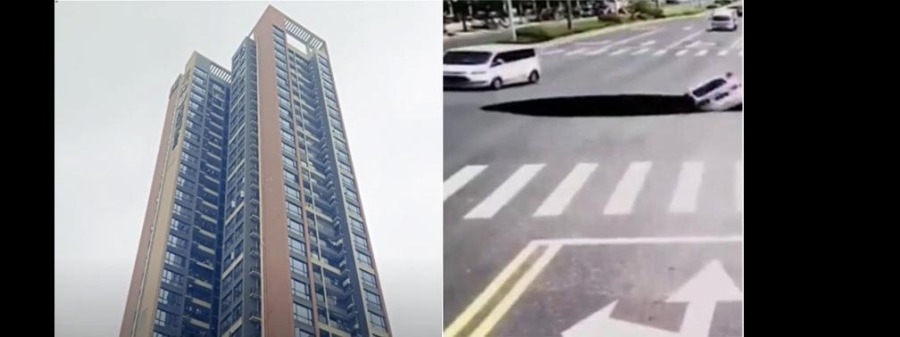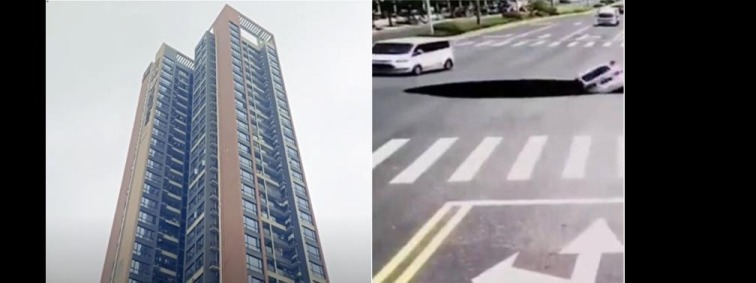China’s real estate market
[People News] China’s real estate market is truly finished. Don’t even talk about the so-called “Golden September and Silver October”—it’s not even worth scrap metal now. Countless families and middle-class people are losing sleep at night. The real estate data remains frigid and frozen, cutting straight to the heart.
Look at the data released in October by the National Bureau of Statistics: among the 70 large and medium-sized cities, prices of newly built commercial housing fell month-on-month by 0.3%, 0.4%, and 0.5% in first-, second-, and third-tier cities respectively. Second-hand housing prices dropped 0.9% month-on-month; Beijing fell 1.1%; Shanghai, Guangzhou, and Shenzhen each dropped 0.9%.
The year-on-year drop is even more miserable. New-home prices in Beijing, Guangzhou, and Shenzhen fell by 2.0%, 4.2%, and 2.6% respectively. Second-tier cities fell 2% year-on-year; third-tier cities fell 3.4%. Second-hand housing is even more tragic: prices in first-tier cities dropped 4.4% year-on-year, an increase of 1.2 percentage points from last month. Guangzhou fell 6.4%, the highest; Beijing, Shanghai, and Shenzhen dropped 4.7%, 3.4%, and 3.3% respectively. Second-tier cities fell 5.2%, and third-tier cities fell 5.7%.
The CCP still shamelessly claims that this year’s real estate policies have taken effect, that decline has stopped, and the market is stabilizing into a continued adjustment phase. According to data from Centaline Property Research Institute, in the first 10 months of 2025, around 200 provinces, cities, and counties introduced more than 500 policies nationwide. That means an average of two real estate policies per day—performing one to two major surgeries a day—yet none can stop the bleeding or revive the housing market.
Let’s combine specific real-world conditions and talk about the bleak landscape of the property market. The five major signals are extremely unusual:
Signal 1: October’s new household loans hit the lowest negative level in history
In 2025, in order to stimulate the economy, the CCP flooded both fiscal and monetary policy with unprecedented liquidity. But the market simply couldn’t bear the weight. Bloomberg reported that China’s financial sector, in order to meet higher-level loan quotas, fabricated loans, creating false intra-bank circulation. Loan officers looked for business owners, issued loans, then had the money returned to the bank a month later, with interest paid by the bank itself—creating ghost loans to beautify lending indicators.
Corporate loan fraud can pass unnoticed. Household loans? Impossible—because household loans go directly into the housing market. Now everyone is unemployed, struggling to find work—who’s still taking out mortgages to buy houses?
The central bank’s social financing data on Nov. 13 slapped its own monetary policy in the face. In October 2025, new household loans were negative 360.4 billion yuan, the lowest level since 2016. In October 2016, new household loans were 433.1 billion yuan, when housing prices were near peak.
In the first 10 months of this year, cumulative new household loans were 739.6 billion yuan. Ten years earlier, in 2016, the cumulative figure for the same period was 5.1531 trillion yuan—an 85% drop, cut at the ankles.
When did the turning point appear? 2022. In October 2022, new household loans plunged from 464.7 billion yuan in October 2021 to negative 18 billion yuan. In the first 10 months of 2022, cumulative loans fell from 6.8147 trillion yuan in 2021 to 3.392 trillion yuan—cut in half.
After the CCP’s severe “three red lines” policy for real estate financing and the torment of dynamic zero-COVID, the consequences appeared after about two years.
Signal 2: Borrowing money to sell houses — mortgages go upside-down
In China today, nothing strange is surprising anymore. With the economic downturn, bizarre phenomena are emerging: young people can’t find jobs, “full-time children” have appeared, education degrees are depreciating, and PhD graduates can’t find work. Housing prices are falling, and people are borrowing money to sell homes—this is the property market turning inside out.
Recently, mainland media outlets such as Economic Observer and Yicai reported that because home prices have fallen too sharply, prices no longer cover remaining mortgage balances. Homeowners, wishing to cut losses before prices fall further, consider selling. But even selling at full price is not enough to pay off the outstanding mortgage. Before selling, they must clear the mortgage—so they must borrow money or take out bank loans to cover the gap. Only then can they sell the house and stop the losses in time.
Borrowing to sell a home happens because of “upside-down mortgages.” The direct cause is the rapid and large decline in second-hand housing prices. According to China Index Academy, the average price of second-hand housing across 100 cities in October was 13,268 yuan/sqm, down 0.84% month-on-month and 7.60% year-on-year.
But fundamentally, people boarded a pirate ship. At the peak of China’s real-estate-and-infrastructure frenzy, many bought at high prices, binding themselves to the CCP’s so-called economic “China speed.” Today’s post-90s and post-00s generations see clearly—they lie flat and refuse to buy anything. “We are the last generation.” And this alone is enough to collapse the CCP’s system.
Signal 3: Banks directly selling houses
Banks selling houses? Yes, you heard correctly—another absurdity in the Celestial Empire.
Have you heard of hospitals selling their own medical equipment? No. Hospitals rely on treating patients to earn money; medical devices are tools for making money. If a hospital sells off its entire building and equipment, it means it’s going bust—no patients, so it must liquidate its assets.
Likewise, banks make money from loan interest; personal mortgages are prime assets. When banks sell houses, they are selling foreclosed homes from people who can’t repay mortgages. Selling below market price without going through judicial auctions pushes housing prices down, triggering more defaults, leading to more direct sales—forming a vicious cycle. This can quickly lead to systemic financial risks caused by a collapsing property market.
This is not alarmist. Recently, the six major state-owned banks are rumored to be supplying houses directly to the market. But among rural commercial banks and local banks with weaker qualifications, the numbers reach tens of thousands of homes.
According to Economic Observer:
Sichuan Rural Credit system listed 24,821 properties;
Guangdong Rural Credit listed 12,386;
Liaoning listed 11,369;
Guizhou listed 9,539;
Jilin listed 2,374;
Fujian listed 623.
Among big banks:
Agricultural Bank listed 3,436,
CCB listed 1,571,
Postal Savings Bank listed 1,091.
Direct-sale prices are 25% below market price, and banks in Wuhan, Chongqing, Yanjiao, Jiashan, and others are selling at 35% to 45% below market price.
Why sell directly? Isn’t there judicial foreclosure?
Because there are too many foreclosure properties, and prices are too low.
China’s average mortgage-default rate has reached 3.7%, up 130% from 2022.
In June 2025, judicial auction supply hit 32,000 units, but transaction rates remained sluggish. Final transaction discounts averaged 31.3%. Banks can’t recover enough cash this way.
Moreover, foreclosure cycles take 2–3 years, and banks face legal limits—they cannot hold non-performing assets longer than two years.
With no other way, banks are personally stepping in: courts transfer property titles to banks, and banks sell directly.
But even then, the market remains cold.
Industry insiders expect bank direct-sales to grow further amid falling prices and economic downturn—posing major risks to both finance and housing.
Signal 4: State-owned enterprises dumping properties in bulk
It’s not just banks—local state-owned assets are also rushing to sell homes.
Yicai reported on Nov. 13 that Sichuan Gongxin Auction Co. will publicly auction 144 housing units (three asset packages totaling 12,000 sqm), including 35 units of affordable housing, 69 units in a residential community, and 40 units in West and East districts. Buyers with good credit can get 75% bank mortgages, with only 25% down payment.
In Beijing, Tianheng Group under Xicheng District SASAC listed 111 homes on the Beijing Property Exchange, worth over 300 million yuan—many in prime locations.
Fuzhou’s Public Resources Trading Center is listing 302 homes owned by the city’s Land Development Center.
In Shandong, state-owned companies in Yantai, Liaocheng, and Zibo are listing hundreds of homes, shops, and parking spaces worth tens of millions.
State-owned companies selling homes is not new, but this level of crowded dumping is unprecedented. Why?
-
Falling prices—sell early to cut losses.
-
Homes are expensive to maintain—high vacancy, low rent-to-price ratio.
-
Local finances are collapsing—even pensions can’t be paid—no money to maintain properties.
-
China’s new “three-assets” reform (resources → assets, assets → securities, funds → leverage). Selling homes is a direct form of asset monetization to strengthen local finances.
But the same logic applies: this is another blow to the housing market. Yet with disaster looming, everyone is saving themselves first—whoever sells earliest escapes earliest.
Signal 5: Real estate kicked out of the policy framework
Banks and state-owned enterprises are dumping property not simply as market behavior—there is political risk forecasting and policy interpretation behind it.
The CCP’s 15th Five-Year Plan Proposal Draft contains 20,000 words, but real estate gets only a short 144-word section. In the 13th Five-Year Plan, it had 617 words; in the 14th, 514 words. The real estate section has shrunk dramatically. More importantly, the CCP has moved real estate into the chapter on “improving people’s livelihood”—after employment, income distribution, education, and social security. This is a downgrade from previous policy priority.
Some mainland commentary claims this means real estate is being expelled from the CCP’s policy decision-making core.
And in risk-prevention priorities, real estate is now listed before local government debt and small/medium financial institutions.
In the CCP’s upcoming strategic goals, real estate will be merely contained to avoid systemic explosions. As for the rest—let it rot. Large-scale stimulus is impossible. “Saving the property market” is pure fantasy.
What will the CCP focus on next?
AI, chips, robotics, quantum tech, blockchain, biotechnology, gene tech, clean energy, nuclear tech.
It wants to compete with the U.S. for global dominance, choke the world in tech, energy, and manufacturing, and “manage the entire planet.”
As for people’s livelihood—you will only hear thunder. There will never be a drop of rain.
(First published in People News) △









News magazine bootstrap themes!
I like this themes, fast loading and look profesional
Thank you Carlos!
You're welcome!
Please support me with give positive rating!
Yes Sure!